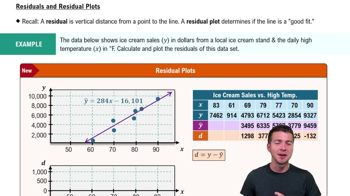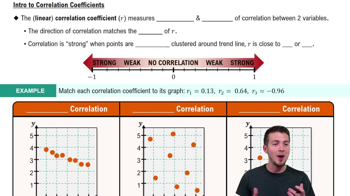The dotplot below shows the number of books read in a month by students in a college class. Find the most and least frequent number of books read.
Table of contents
- 1. Intro to Stats and Collecting Data1h 14m
- 2. Describing Data with Tables and Graphs1h 55m
- 3. Describing Data Numerically2h 5m
- 4. Probability2h 16m
- 5. Binomial Distribution & Discrete Random Variables3h 6m
- 6. Normal Distribution and Continuous Random Variables2h 11m
- 7. Sampling Distributions & Confidence Intervals: Mean3h 23m
- Sampling Distribution of the Sample Mean and Central Limit Theorem19m
- Distribution of Sample Mean - Excel23m
- Introduction to Confidence Intervals15m
- Confidence Intervals for Population Mean1h 18m
- Determining the Minimum Sample Size Required12m
- Finding Probabilities and T Critical Values - Excel28m
- Confidence Intervals for Population Means - Excel25m
- 8. Sampling Distributions & Confidence Intervals: Proportion1h 12m
- 9. Hypothesis Testing for One Sample3h 29m
- 10. Hypothesis Testing for Two Samples4h 50m
- Two Proportions1h 13m
- Two Proportions Hypothesis Test - Excel28m
- Two Means - Unknown, Unequal Variance1h 3m
- Two Means - Unknown Variances Hypothesis Test - Excel12m
- Two Means - Unknown, Equal Variance15m
- Two Means - Unknown, Equal Variances Hypothesis Test - Excel9m
- Two Means - Known Variance12m
- Two Means - Sigma Known Hypothesis Test - Excel21m
- Two Means - Matched Pairs (Dependent Samples)42m
- Matched Pairs Hypothesis Test - Excel12m
- 11. Correlation1h 6m
- 12. Regression1h 50m
- 13. Chi-Square Tests & Goodness of Fit1h 57m
- 14. ANOVA1h 57m
2. Describing Data with Tables and Graphs
Dot Plots
Problem 2.R.11
Textbook Question
The heights (in feet) and the number of stories of the ten tallest buildings in New York City are listed. Use a scatter plot to display the data. Describe any patterns. (Source: Emporis)

 Verified step by step guidance
Verified step by step guidance1
Step 1: Organize the data into two variables: 'Height in feet' and 'Number of stories'. These will serve as the x-axis and y-axis for the scatter plot, respectively.
Step 2: Create a scatter plot by plotting each pair of values (height, stories) as a point on a Cartesian plane. For example, the first point would be (1776, 104), the second point (1550, 95), and so on.
Step 3: Label the axes of the scatter plot. The x-axis should represent 'Height in feet', and the y-axis should represent 'Number of stories'. Include appropriate units for clarity.
Step 4: Analyze the scatter plot for patterns. Look for trends such as whether taller buildings tend to have more stories, or if there are any outliers that deviate significantly from the general trend.
Step 5: Summarize the observed patterns. For example, you might note whether there is a positive correlation between height and the number of stories, or if the relationship appears non-linear or inconsistent.
 Verified video answer for a similar problem:
Verified video answer for a similar problem:This video solution was recommended by our tutors as helpful for the problem above
Video duration:
2mPlay a video:
Was this helpful?
Key Concepts
Here are the essential concepts you must grasp in order to answer the question correctly.
Scatter Plot
A scatter plot is a graphical representation that uses dots to display values for two different variables. In this case, the heights of buildings are plotted on one axis and the number of stories on the other. This visualization helps identify relationships or patterns between the two variables, such as whether taller buildings tend to have more stories.
Recommended video:
Guided course

Residuals and Residual Plots
Correlation
Correlation refers to the statistical relationship between two variables, indicating how one may change in relation to the other. In the context of the scatter plot, a positive correlation would suggest that as the height of a building increases, the number of stories also increases, while a negative correlation would indicate the opposite. Understanding correlation is essential for interpreting the patterns observed in the data.
Recommended video:
Guided course

Correlation Coefficient
Descriptive Statistics
Descriptive statistics summarize and describe the main features of a dataset. This includes measures such as mean, median, and range, which provide insights into the central tendency and variability of the data. In analyzing the scatter plot, descriptive statistics can help quantify the relationship between building height and the number of stories, aiding in a more comprehensive understanding of the data.
Recommended video:
Guided course

Parameters vs. Statistics
Related Videos
Related Practice
Multiple Choice


